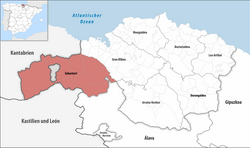You can help expand this article with text translated from the corresponding article in Spanish. (June 2023)Click [show] for important translation instructions.
|
Enkarterri | |
|---|---|
 | |
 Location of Enkarterri in Biscay | |
| Country | Spain |
| Autonomous community | Basque Country |
| Province | Biscay |
| Municipalities | List |
| Population | |
• Total | 32,277 |
| Demonym | encartados |
| Time zone | UTC+1 (CET) |
| • Summer (DST) | UTC+2 (CEST) |
Enkarterri (Spanish: Las Encartaciones) is a comarca of the province of Biscay, in the Basque Country, Spain. It is one of the seven eskualdeak/comarcas or districts that make up the province of Biscay. Its administrative centre is Balmaseda.
Contents
Historically a larger region (merindad), Enkarterri stretched from the mountains that form its southern border with Cantabria and Castile-Leon in the west and south, to the river Nervión and the Estuary of Bilbao in the east – including the industrial municipalities of Gallarta, Muskiz, Ortuella, Portugalete, Santurtzi, Sestao, Trapagaran and Zierbena. Nowadays the name usually refers only to the rural western part of the historical territory, while the eastern urban area is known as the Left Bank (Margen Izquierda / Ezkerraldea) and is part of the Greater Bilbao comarca (together with Barakaldo, which used to belong to the neighbouring merindad of Uribe).
